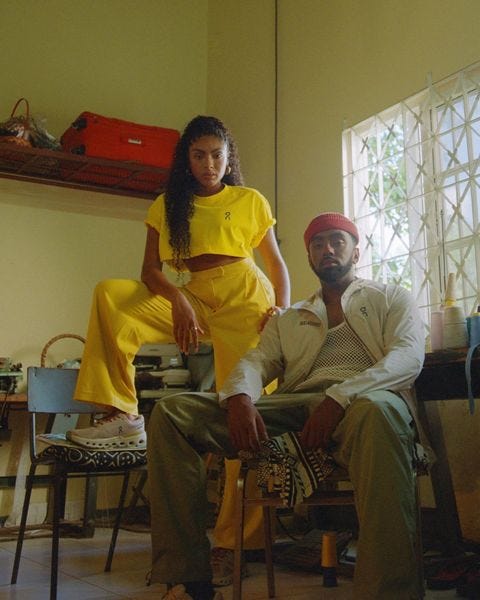The Blurry Line Between Runner and Creative
The power of the creative and the camera in building community.
As part of the gen-z search for community and purpose, I have noticed that running is taking off as the new “cool thing.” The mental/physical challenge, low barrier to entry, and proliferation of running clubs in all major cities, are strong contributors to this phenomenon. Not only has the amount of runners increased, but also the people watching the sport.
My dad ran the Madrid marathon last weekend and as I jumped on the metro trying to see him in different locations, I was shocked to see the locals, even those who had no personal connection to a runner, come together to support all participants. Despite my initial surprise, while researching for this piece, I have come to find that Madrid’s reaction was tame, in cities like London or New York, people talk about watching the marathon like some would talk about seeing their favorite band preform.
This, in turn, has given the rise to fun banners that people hold up while racers speed by. I saw a lot of photographers on Twitter and Threads photographing the signs (I was guilty of this too in the Amsterdam marathon), but I think that this takes away from the cultural and visual impact that the rise of running is creating.
Coincidentally, a lot of photographers I follow also happen to be runners, and because they have photographer friends, they come out of their races with both a medal, and stellar photos of their performance. A great example of this is Joe Greer, shot by Raphael Lehnen,
or Eric Floberg, shot by Cyrus Hannah.
For me, what this has done is shine a spotlight on runners not only as athletes but also as creatives. As the Fashion Publication SOTA points out, “Running clubs have become the new creative collectives, pockets of influential people come together not just to run, but to share and exchange ideas, collaborate, and also flex.” The microcosm of creatives in the running world has led to Greer working as a photographer for Bandit Running, and Floberg for BPN.
This, partnered with giants like Adidas and Nike diversifying to traditional streetwear and other sports, has created a sharp increase in niche running brands like Patta, On, Hoka (less niche but also stemming from this phenomenon), Norda, UVU, and Bandit. In turn, these brands have become streetwear worthy, showing both athleticism, style and status.
Their marketing campaigns, reflect this change, as often geared towards creatives and their friends, they tend to be shot on film or edited to mirror nostalgic colorways.
This Bandit Campaign shot by Joe Greer highlights the above, as it was captured on film, and carefully curates colors in a way that accentuates Bandit’s range and style. Not only this, but the shoot itself, taking place in Greenpoint rather than at a running track, emphasizes that yes, this is a running brand and products can be used for running, but they can be much more than that.
Similarly, this On x Walkgood collaboration boasts similar ideas, emphasizing that the running brand can be about both about running and community. Like Greer’s work for Bandit, in this image the highlights are lowered, and the shadows are lifted, creating a nostalgic film like look that attracts creatives like a moth to a flame.
The proliferation of these brands and this style has led larger companies that had fallen off with their running marketing, to adopt some of the same techniques.
This Nike campaign shot by Charlotte Patterson clearly exemplifies it. Although the photos are very much geared towards running, the methods, with the slower shutter speed and what looks like a double exposure of the runner and the empire state in the background, show much more artistic ambition than a shot of the shoes on a track. Staying true to their Nike style, the images are embossed with a logo, in this case, “leave yourself in the dust,” which leaves them less open to interpretation than the smaller brands explored above. Although there is a strong emphasis on running, the empire state in the background stands as an emblem for NYC’s multiculturality, showing that the sport can adapt to all, thus visually embodying the ethos of many of the smaller brands.
The ability to shape what a Nike campaign will look like is exclusively the result of smaller runner brands putting their community first and being creative driven. The power of a visual, in this case the photograph, is what will keep attracting younger runners towards the smaller brands, as within the threads of shoes, shorts, or sports bras, a support system and community is interwoven, creating a quality of costumers and supporters that the giants will always struggle to acquire.









